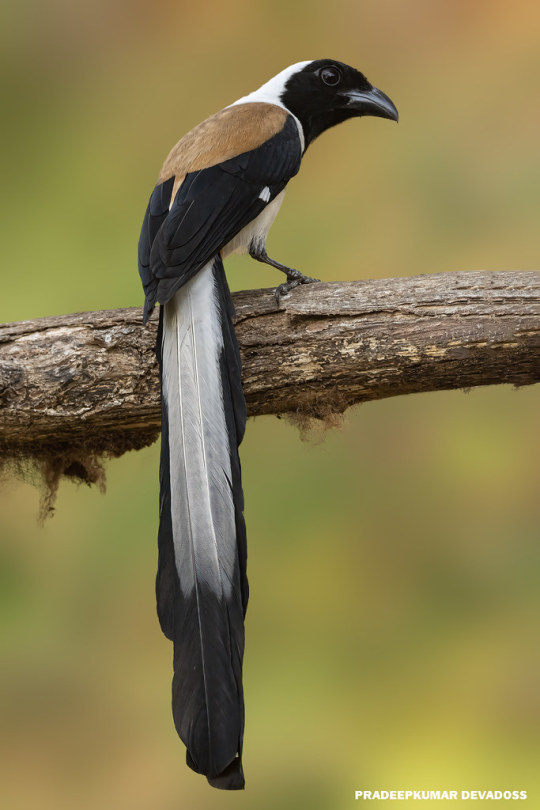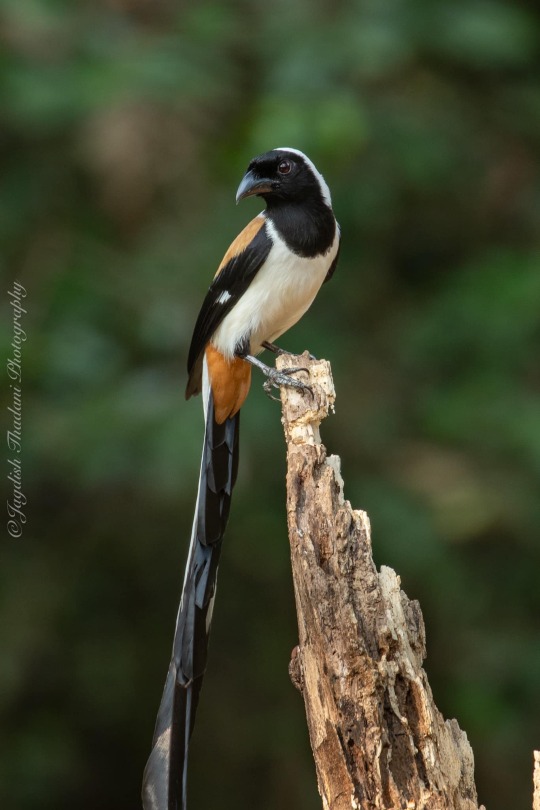#dendrocitta leucogastra
Explore tagged Tumblr posts
Photo

White-bellied Treepie
104 notes
·
View notes
Photo

A new variant has been added!
White-bellied Treepie (Dendrocitta leucogastra) © John Gould
It hatches from black, handsome, hooting, human, humid, long, noisy, other, primary, secondary, upper, western, and white eggs.
squawkoverflow - the ultimate bird collecting game 🥚 hatch ❤️ collect 🤝 connect
2 notes
·
View notes
Text

White-bellied Treepie (Dendrocitta leucogastra), family Corvidae, order Passeriformes, Karnataka, India
photograph by Krishnaraj Jayaram
957 notes
·
View notes
Text

[https://www.inaturalist.org/observations/197196563] White-Bellied Treepie || Dendrocitta leucogastra Observed in India Least Concern in location of observation
#ornithology#corvid#birds#nature#wildlife#photography#air beast#who cooks for queue? who cooks for queue all?
198 notes
·
View notes
Text






9) Dendrocitta leucogastra; Sroka białobrzucha, white-bellied treepie (srokówka białobrzucha) - ptak z rodziny krukowatych, endemiczny dla lasów południowych Indii. W niektórych obszarach pokrywają się one pod względem rozmieszczenia z rufous treepie, ale łatwo je odróżnić zarówno po wyglądzie, jak i zawołaniu.
Występuje w lasach Ghatów Zachodnich, głównie na południe od Goa. Dane z Erimalai niedaleko Dharmapuri[6] oraz w Surat Dangs i południowo-wschodnich Ghatów w stanie Andhra Pradesh wykraczają poza główny zasięg występowania. Zapis ze środkowych Indii (Chikalda, Gawilgarh) został zakwestionowany.
Jest kojarzony ze stadami żerującymi na różnych gatunkach i często spotykany razem z drongo rakietowatymi większymi.
0 notes
Photo

White-bellied Treepie (Dendrocitta leucogastra)
© Pradeepkumar Devadoss
18 notes
·
View notes
Text


I am back with my silly sci-fi birds, and today we have the Krau brothers. They’re White-Bellied Treepies (Dendrocitta leucogastra). They’re from the same clutch but different eggs; essentially their version of fraternal twins. They were born on a now-abandoned settlement at the edges of the Interstellar Union of Planetary Republics.
Critch, the bird with red eyes and a crest, is the captain of their ship (the ISRS Easterly Winds). He’s young and inexperienced, often making less-than-stellar decisions. Despite this, he’s proud and always seeking a name for himself, sometimes to a fault. One might wonder if he’s trying to compensate for something. While it’s rarely referenced, he is transsexual.
Kri’ao (or just Kri, if you’re Critch) is the one with brown eyes. He’s the ship’s navigator and tack-sharp with maths. Like his brother, he’s impulsive and confident, but unlike him, he’s communicative. More often than not, his job includes being a go-between for Critch and his least favorite corvid, R’That’Lat’Tat.
#Art#digital art#digital drawing#artwork#drawing#corvid#corvids#corvidae#white bellied treepie#Treepie#Procreate#oc#oc art#bird oc#bird characters
0 notes
Photo




10] Sroka białobrzucha (Dendrocitta leucogastra) (white-bellied treepie) - jest ptakiem z rodziny krukowatych, endemicznym dla lasów południowych Indii. W niektórych obszarach pokrywają się rozmieszczeniem z rufous treepie, ale łatwo je odróżnić zarówno z wyglądu, jak i przywołania.
0 notes
Text
NAGARHOLE NATIONAL PARK
It is a part of Nilgiri Biosphere Reserve also known as ‘Rajiv Gandhi National Park’, is one of India’s best known wildlife reserves. This place beckons tourists from all over the world to have a rendezvous with nature and wildlife. It was set up in 1955, enriched with greenish forest cover, little streams, softy valleys and spectacular waterfalls, is one of the best-managed parks in the country.
Naga means snake , hole means pond or stream in local parlance. There is a steam in the west side of the park called Nagarhole. So the name of the park
Fauna of Nagarhole National Park
Sambar deer in nagarhole
Four-horned Antelope (Tetracerus quadricornis) , Indian Palm Squirrel (Funambulus palmarum) also known as Three Striped Palm Squirrel, Indian giant squirrel ( Ratufa indica ) or Malabar Squirrel, Flying squirrel ( Biswamoyopterus biswasi) , Slender loris (Loris tardigradus), Royal Bengal tiger (Panthera tigris or Panthera tigris bengalensis), Sambar (deer) , Porcupine , Wild Boar , Panther , Pangoline , Otter, Striped necked mongoose (Herpestes vitticollis), Small Indian Mongoose (Herpestes javanicus), Common Mongoose (Herpestes edwardsi) , Bonnet Macaque (Macaca radiata) , Sloth Bear (Melursus ursinus), Barking Deer (Muntjac) ,Mouse Deer (Chevrotain), Spotted Deer ( Axis axis) , Common Langur (Hanuman Langur or Presbytis entellus), Wild Dog, Jackal , Civet Cat , Gaur and Elephant.
Birds of Nagarhole National Park
Nal salovar
Peafowl ( Pavo cristatus) , Common Babbler(Turdoides caudata ), Reed Warbler, Bea-eater, Red-whiskered Bulbul ( Pycnonotus jocosus ) , Red-vented Bulbul (Pycnonotus cafer) , Brown dove, Blue-winged Parakeet ( Malabar Parakeet or Psittacula columboides) , Alexandrine Parakeet (Psittacula eupatria) , Ring-Necked Dove (Streptopelia capicola), Spotted Dove (Streptopelia chinensis), Malabar Grey Hornbill ( Ocyceros griseus ) , Malabar Pied Hornbill (Anthracoceros coronatus) , Crested Hawk eagle ( Nisaetus cirrhatus cirrhatus) , Crested Serpent Eagle ( Spilornis cheela or Kanmuri-washi ) , Tawny Eagle (Aquila rapax ) , Blyth’s Myna (Sturnus malabaricus blythii) , Small Minivet ( Pericrocotus cinnamomeus ) , Lorikeets, Blossom-headed Parakeet (Psittacula roseata) , Rose-ringed Parakeet (Psittacula krameri), Southern Treepie (Dendrocitta leucogastra) , Green Imperial Pigeon (Ducula aenea) , Malabar Trogon ( Harpactes fasciatus ) and Bar-winged Flycatcher shrike ( Hemipus picatus ).
Reptiles of Nagarhole National Park
King Cobra, Spectacled cobra ( Common cobra or Naja naja), Banded Krait (B. fasciatus), Bamboo viper ( Trimeresurus stejnegeri ) , Pit viper, Russell’s viper, Indian Rock Python (Python molurus ), Monitor Lizard, Tortoise and Toads.
Elephant in nagarhole
Location
Nagarhole National Park spreads over two districts of Karnataka state – Mysore and Kodagu. Its a relatively large national park covering an area more than 600 sq. kilometers ( 230 sq miles)
Nagarhole Opening Hours
The main road through the park is open from 6 a.m. until 6 p.m., all year round. Safaris take place in the early morning from 6 a.m to 9 a.m., and again in the afternoon from 3 p.m. to 5 p.m.
Nagarhole Cost
The park entrance fee is 200 rupees ($4.50) for foreigners. The forest department runs one hour safaris for 65 rupees ($1.50). Alternatively private vehicles can go on safari for 550 rupees ($12) per car or jeep, plus 200 rupees for the cost of a guide (required). Trekking costs 75 rupees ($1.80) for one day, plus 250 rupees ($6) for a guide. A 30 minute elephant ride costs 75 rupees. Jeeps can be hired for around 800 rupees ($18) per day from the forest department office in Hunsur, 45 kilometers before the park. Hotel operators also run safari tours and other activities.
MaleGaur in Nagarahole
Nagarhole Travel Tips
Nagarhole can be explored by jeep, elephant back, and boat. Visitors can also go trekking. The park offers the opportunity to see elephants close up in their natural habitat, and it’s not unusual to see herds of elephants on the river bank. However, the likelihood of seeing a tiger here is rare compared to parks such as Bandhavgarh in the north. A good thing about Nagarhole is that the main forest reserve office (where the safaris start from) is located right inside the park. This means that visitors can pass through quite a bit of the park area on their own.
How to get there
Tiger
By Road
Nagarhole National park is well connected to adjoining areas of Karnataka. Motorable highways link the park to the towns of Madikere (90 km) and Mysore (96 km) . The journey from both places lasts approximately 2 hours.
By Rail
The nearest well-connected railway junction is Mysore.
By Air
The nearest international airport is Bangalore (220 km). Various airlines link Bangalore to the rest of the nation.
Gallery
Deers at night
Sambar deer in nagarhole
Elephant in nagarhole
MaleGaur in Nagarahole
Nagarhole park entry
Tiger
Nagarhole National Park NAGARHOLE NATIONAL PARK It is a part of Nilgiri Biosphere Reserve also known as 'Rajiv Gandhi National Park', is one of India’s best known wildlife reserves.
#deers in nagarhole#Elephant in nagarhole#KARNATAKA#NAGARHOLE#RAJIV GANDHI NATIONAL PARK#Sambar deer in nagarhole
0 notes
Text

White-bellied Treepie (Dendrocitta leucogastra), family Corvidae, order Passeriformes, Kochi, India
photograph by Jagdish M Thadani
474 notes
·
View notes
Text

White-bellied Treepie (Dendrocitta leucogastra), family Corvidae, order Passeriformes, Kerala, India
photograph by Davidvraju
213 notes
·
View notes
Text

White-bellied Treepie (Dendrocitta leucogastra), family Corvidae, endemic to southern India
photograph by Davidvraju
201 notes
·
View notes
Text

White-bellied Treepie (Dendrocitta leucogastra), family Corvidae, endemic to southern India
Photograph by Sadiq Chithara
121 notes
·
View notes
Text

[https://www.inaturalist.org/observations/50388830] White-Bellied Treepie || Dendrocitta leucogastra Observed in India Least Concern in location of observation
#ornithology#corvid#birds#nature#wildlife#photography#air beast#who cooks for queue? who cooks for queue all?
9 notes
·
View notes